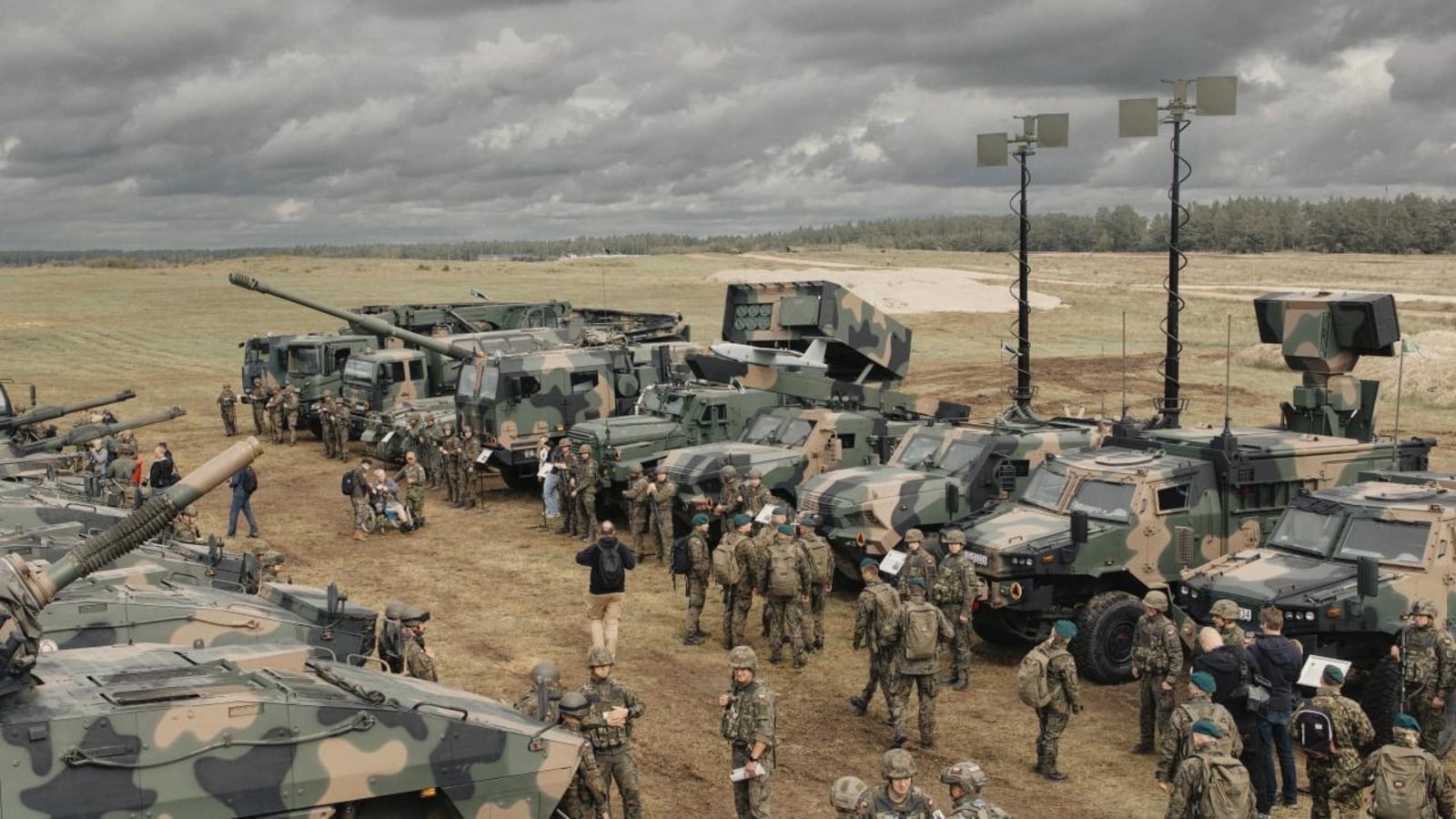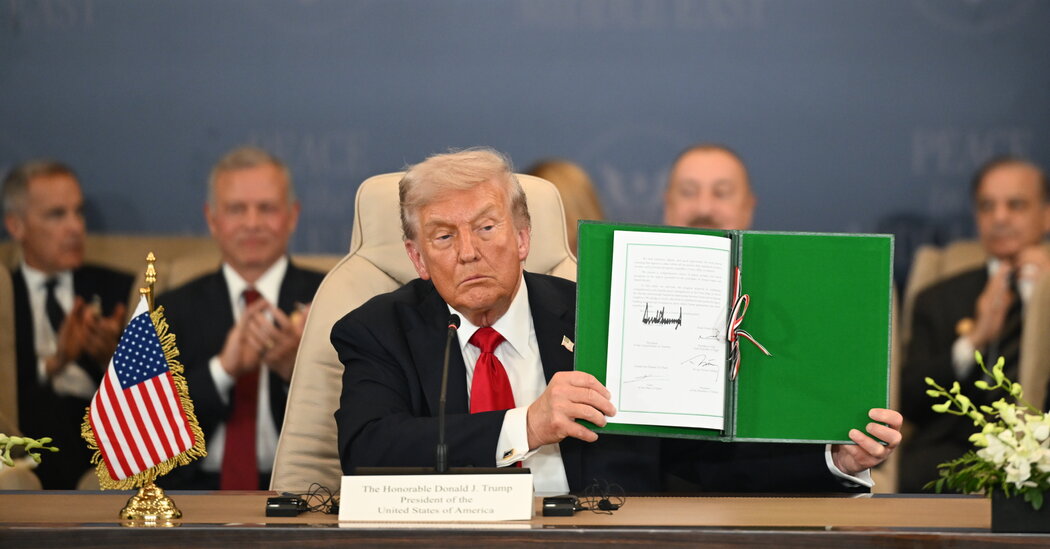With an eye on growing Russian aggression in Europe, Warsaw’s military planners built out the country’s armed forces, turning it last year into the largest European military in the North Atlantic Treaty Organization. It ramped up military spending to 4.7% of gross domestic product this year—the highest in the alliance. A multibillion-dollar spending spree has put Poland among the biggest buyers of U.S. weapons.
The growth of the Polish military has reached a zenith just as Russian President Vladimir Putin escalates his standoff with the West. Last month, Polish airspace was violated by some 20 Russian drones, equipped with additional fuel tanks to help them fly farther.
The incursion, followed by other UAV sightings across Europe, triggered the first confrontation between NATO jet fighters and Russian drones over alliance territory—a step Polish Prime Minister Donald Tusk said had brought the country closest to open conflict since World War II. Putin has dismissed the drone incident and says European governments and NATO accuse it of provocations on a nearly daily basis.
Russia’s 2022 full-scale invasion of Ukraine and recent steps to test the alliance have highlighted Poland’s long-ignored warning that Russia, under Putin, wants to resurrect its traditional sphere of influence in Eastern Europe.
Poland suffered under Russian occupation for centuries. Every schoolchild learns how larger European empires, including Russia, divided up the country among themselves in the 18th and 19th centuries, temporarily erasing it from the map. In WWII, the U.K. and France failed to prevent the country’s invasion by the Nazis, despite mutual defense treaties. When the Soviets followed with their own invasion, it led to half a century under Moscow’s heel.
Russia’s moves against Ukraine and now Europe make Polish policymakers nervous that they again are in the firing line—and this time Poland wants to be ready.
“This is our war,” Tusk said at the Warsaw Security Forum in September. “We decided to arm Poland and modernize the Polish army on a massive scale.”
Poland’s military spending has endeared it to both its neighbors on NATO’s eastern flank and to President Trump, who wants to see Europe take care of more of its own security needs. In a meeting with new Polish President Karol Nawrocki, Trump extended his backing to Poland in a way he has offered few other European countries.
“We are with Poland all the way and we will help Poland protect itself,” he said.
In a trip to the Polish capital earlier this year, U.S. Defense Secretary Pete Hegseth said Warsaw is “a model ally.”
Russia is ambiguous about its intentions toward NATO. Late last year, Russia’s Defense Minister Andrei Belousov said Moscow’s military must be ready for a conflict with the alliance. At the same defense ministry meeting, Putin poured cold water on the idea and said the West was scaring its own population with fears that Russia was ready to attack. Earlier this month, he said the idea of Russia attacking NATO was nonsense and that Europe should deal with its own problems of migration and violence before picking a fight with Russia.
The Kremlin, though, has asked Trump to withdraw NATO troops and weapons from Central and Eastern Europe back to where they stood before the bloc’s eastward expansion began in 1999. It made a similar demand of former President Joe Biden before the invasion of Ukraine, Western intelligence officials say.
“Russia’s strategy is to resurrect the Soviet Union,” said Polish Defense Minister Wladyslaw Kosiniak-Kamysz. And that would put Poland in the crosshairs.
The country resolved to prepare itself for the possibility of a new conflict after Russia annexed the Crimean Peninsula from Ukraine in 2014 and launched a proxy war for control of the Donbas region.
While much of Europe was left hoping that would be the end of Russian aggression on the continent, Polish war planners spent a year analyzing the worst-case scenarios before they set out a series of reforms to expand the military, rapidly increasing the number of troops and boosting their tool kit.
Other European countries were “waiting for someone else to make the first move,” said Tomasz Szatkowski, a former Polish undersecretary of defense, who oversaw the strategic defense review that started its military reforms. “In the end, we were further ahead, not just of the rest of the eastern flank, but ahead of most countries in European NATO.”
Poland now has more than 210,000 military personnel, behind only the U.S. and Turkey in NATO. The first unit created after the reforms in 2018 was the 18th Mechanized Division, which is kept in a state of heightened readiness. Two more similar units are in the process of being formed. It has also created its territorial defense forces with tens of thousands of troops.
Training is a priority. Last month, 30,000 troops, including from the 18th Division and U.S. and Dutch forces, embarked on a monthlong series of wargames, named Iron Defender, which gave Polish troops a chance to train on their arsenal of old and new weapons. Those included U.S. Abrams tanks, South Korean multiple rocket launchers and a Polish variant of the U.S. High Mobility Artillery Rocket System, or Himars, which Ukraine has used against Russia.
Poland’s forces are increasingly well-equipped. Much of the equipment Poland has bought in the past few years is starting to roll in, and there is more to come. The country has bought some $50 billion worth of U.S. weapons, making it the top buyer of U.S. weapons in 2023-2024. Poland plans to boost military spending next year to 4.8%, Kosiniak-Kamysz said recently.
Today, the country finds itself a cornerstone in NATO’s planning for a conflict with Russia, and a crucial partner for the smaller Baltic countries of the alliance’s eastern flank, Estonia, Latvia and Lithuania.
Geography plays an important role. Poland shares not only a border with the Russian exclave Kaliningrad, but also Belarus, a close Moscow ally now enmeshed in Russia’s defense infrastructure. Russia considers Belarus airspace its own, and its railroads can quickly transport Russian troops to the Polish border. Russia has deployed nuclear-capable tactical missiles in Belarus.
“In a crisis, the defense of the Baltics will rely on the ability of the Polish armed forces, reinforced by the U.S., to tackle Kaliningrad and Belarus,” said Szatkowski, also a former Polish ambassador to NATO.
Importantly, Poland has had to sharpen its logistical capabilities over its vast territory to allow for the huge influx of NATO troops that would likely deploy there in case of a conflict. There are planned upgrades to some of its civilian airports to allow them to transport soldiers.
“In the case of war, Poland will be a very busy country because the military will mobilize, the economy will mobilize, but we would also have to prepare for NATO coming to—and through—Poland,” said Operational Commander of the Armed Forces Lt Gen. Maciej Klisz.
The task of building out Poland’s military has left it footing a massive bill. And while the country’s GDP growth for the next few years, expected around 3%, is higher than other European peers, the fiscal demands of maintaining the advanced weapons systems could outstrip Poland’s defense budget.
It is a measure of how seriously Poland and its neighbors see the Russian threat that Poland and Germany are now discussing the possibility of Berlin covering some of the cost as compensation for the damage it caused during WWII.
The German side hopes it would put an end to Polish demands for reparations, while placing the two countries on a similar defense footing.
“For Germans, reparations are a toxic issue,” said Janusz Reiter, Poland’s former ambassador to Germany and the U.S., “unlike the responsibility for securing the eastern flank via Poland.”
Write to Thomas Grove at thomas.grove@wsj.com


